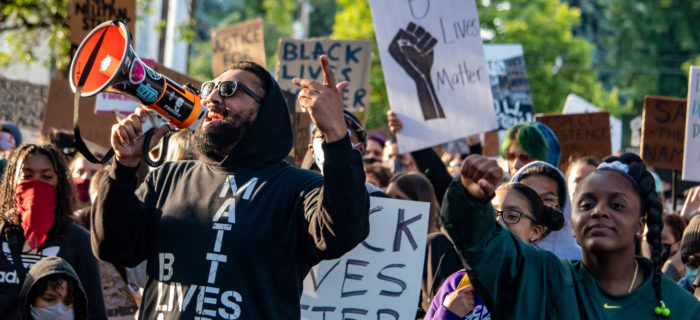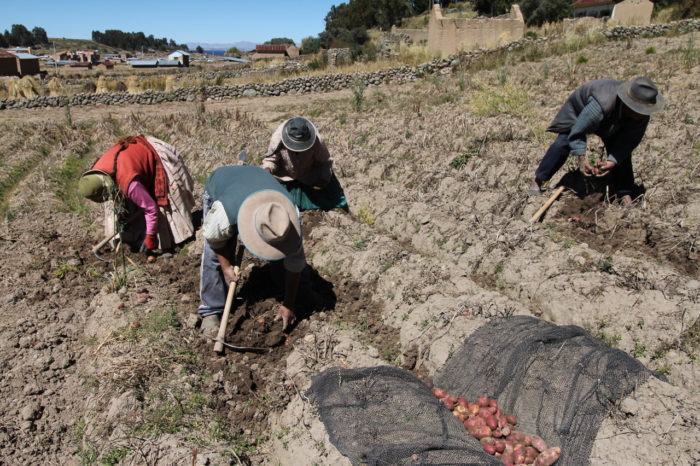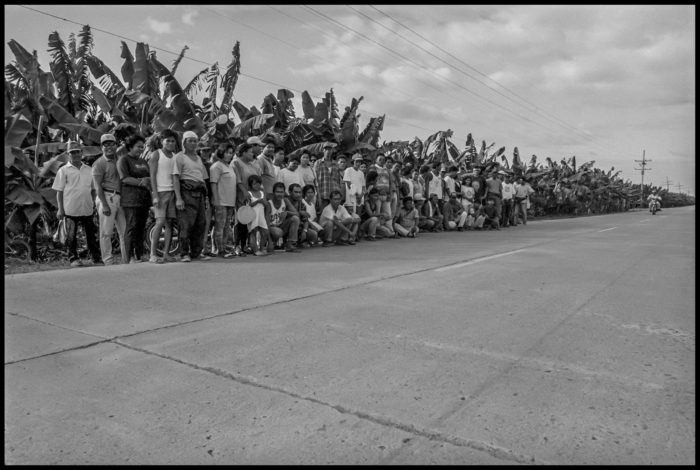News and Views: Fall 2020
Download the PDF version here.
Food First Brings Together Farmers and Scholar-Activists to Share Analysis and Strategies for Our Current Political Moment
Over the summer, former Food First Executive Director, M. Jahi Chappell moderated a compelling conversation over drinks with Ahna Kruzic, Raj Patel, and Jim Goodman. We discussed the massive protests for racial justice, COVID-19, the Green New Deal, and organizing for a just future.
We first started off by discussing how our federal and state governments’ response (or lack thereof ) to COVID-19 reflected an economic system which produces wealth by exploiting and disempowering workers. Nowhere was this more apparent than perhaps the food system, where state governments, such as Iowa, demanded that meatpacking plants stay open despite safety concerns for its workers in order to continue to make profits above all other concerns. As protests against racism were surging through the streets of the US, workers across the United States in the food system, many of whom are disproportionately Black and Latinx, were suffering the brunt of the airborne virus. From the fields to the processing plants to the food service industry, it was these workers who were disproportionately impacted by the virus.
But during this crisis, we also saw mutual aid between people and communities step in when the government failed. We saw small farmers shift their markets to direct-to-consumer when restaurants and schools shut down. We saw explosions of activism as people marched for Black lives in the streets, which wasn’t just the result of spontaneous energy or even despair from the pandemic lockdowns, but years of organizing that made it possible in the first place. As Ahna pointed out, much of this work wasn’t new, but has been part of a process of building relationships and social and political power that has been taking place for decades. This type of social fabric, years in the making, is the bedrock for movements pushing for the sweeping policy changes that we so desperately need.
From there, Jahi guided us into a deep dive into the rich history of multi-racial movements and struggles for a more egalitarian economy and society going back two hundred years. While these movements were also fraught with conflict in one form or another, they help us understand the possibilities for our justice movements today. Raj used the example of the cowboys unionizing in Texas in the late 1800s to show how struggles are always not just about one thing, but are always intersectional. The cowboy strike was about labor, reproductive labor, finance, and dignity, and most importantly, they won victories in their collective struggles. While the cowboy has since become mythologized as the lone, rugged, white individual, the reality is that they were a diverse set of workers who saw themselves as proletarians and knew they had to act collectively in order to improve their lives.
Raj then pivoted to the “survival pending revolution” strategy of the Black Panthers, which focused on strengthening community infrastructure from food to healthcare to physical security. He shared how so much of the methods of communities and movements today are linked to the example that the Black Panthers gave us. But most importantly, Raj pointed out that, like the cowboys of the past, the Black Panthers offer us an extremely useful template of how to organize bottom-up, for the full-scale transformation that we need in order to implement a Green New Deal and more.
Jahi ended the session by asking Jim what these current times mean for farmers like himself? Jim remarked what it was like when Ronald Reagan was first elected president in 1980 and how he felt that was a major, negative turning point for not just unions, but also racial inequality, as well as small and medium-sized farmers. It was a turn for the worse that has been a steady descent since then. But he said that while this moment certainly is a dangerous one, it is also a moment of real possibility and offers us a chance to reconsider the food system that has run into crisis. Like the rest of the world, we have the ability to feed ourselves, if we only allow it. The only way to do this though, is to push back against the industrial food system rooted in the need to profit that prevents so many farmers from working the land in a sustainable way.
Stay in the loop with Food First!
Get our independent analysis, research, and other publications you care about to your inbox for free!
Sign up today!To view the full webinar, please click here.
Fighting Land Grabs with Land Justice
Land is pretty important. It is the foundation of social life. It is the basis for food production, but is also the cornerstone for different societies’ political, economic, social, and cultural ways of life. This may look very different in various parts of the world, but a common feature is that land is power, but power can also dictate access to land. Under a global capitalist system, land has been a central site of profit accumulation, as well as political and social struggles over the past 500 years. Today, land is as valuable as ever to our economic system, which is why land grabs are occurring all over the world, despite its negative impact on local communities and sustainable food systems.
So it was with great pleasure that Food First edited the 40th edition of the Nyéléni Newsletter on land grabs and land justice. This issue brought together the voices and work of farmers, farmworkers, activists, organizers, and scholars in order to properly examine the forces driving land grabs around the world today. The issue also conveys the opportunities and strategies that are being used to fight back against land grabbing and promote positive food system changes through land justice. Covering the globe from both rural and urban United States, to various parts of Africa to Latin America, you’ll get a rich understanding of just what is going on with land grabbing around the world, and what land justice looks like in different contexts. The different perspectives featured make clear that land justice isn’t just necessary for a much better food system, but also for much larger social change in order to help rid us of the many injustices that make up our society.
To read the Nyéléni Newsletter, click here.
Helping to Better Understand the Globalization of Quinoa and Its Effects
Scholars Fabiana Li and Claudia Urdanivia wrote a two-part piece for Food First covering the complex relationships between quinoa farmers in the Peruvian Andes and consumers in the Global North.
Li and Urdanivia show that while indeed the quinoa boom and bust and the increased consumption of quinoa in the Global North has had an effect on Andean farmers’ decreased consumption of their local quinoa, other factors such as the breakup of the hacienda system, rural-urban migration, wage-labor, and food aid programs have all affected the consumption of traditional foods. Therefore, the change in dietary patterns of quinoa farmers is not necessarily all that new, and is part of a much larger, ongoing process that goes beyond increased consumption in the Global North. They show that these farmers’ integration into capitalist markets not just on a global level, but a regional and local one as well, play a prominent role in changing relationships to traditional foods.
Li and Urdanivia highlight how these relationships play out in the scope of globalization. Some regions have benefited from the export of quinoa, but it is uneven and does not come without consequences. Commercialization has led to a decline in the biodiversity of native varieties of quinoa due to the demand of the white quinoa variety. The intensification of large-scale farming of quinoa for export is also degrading the fertility of land in various regions, while increased global market competition is favoring larger landowners over smaller farmers. Li and Urdanivia also point out that the global food system benefits retailers and large exporters, while an increasingly unstable price for quinoa hurts smaller farmers the most. While they point out that consumers in the Global North should try to demand a fairer distribution of profits for smaller farmers, they caution the overemphasis of consumer activism and its limited effects on helping small farmers. Ultimately, they conclude by saying that “the idea that we can make a difference by buying or not buying a particular food like quinoa simplifies the multiple, and sometimes untraceable, nodes of the quinoa commodity chain” and erases Andean farmer’s own decision-making and power over their own lives.
Read part one of the article, click here. To read part two, click here.
Food First Digs Deeper into the Successes and Challenges of the Philippine Banana Cooperative Movement
Earlier this year, before COVID-19 struck the world and the United States, Food First published an Issue Brief titled, Philippine Banana Farmers: Their Cooperatives and Struggle for Land Reform and Sustainable Agriculture by labor photojournalist David Bacon. That piece explored how unionized farmworkers used land reform to become cooperative farmers on land that used to belong to multinational corporations. One institution featured in that story was the Foundation for Agrarian Reform Cooperatives in Mindanao (FARMCOOP), who worked to assist the cooperatives in their struggle for economic viability and sustainability. We sat down to interview one its staff members, Khalil Apuzen Ito to dig deeper into the story of the banana cooperatives, FARMCOOP’s role in supporting them, and why food and farm movements should learn about their successes and challenges.
In the interview, we touched on the initial difficulties the farmworkers-turned-farmers faced after they were given land through the agrarian reforms. While receiving land was an enormous feat, Khalil pointed out that there were still major obstacles facing the cooperative farmers. Newly created governmental departments, who were supposed to assist the new farmers, ended up tending to the needs of multinational corporations in many cases. In addition to this, the cooperative farmers ended up with production contracts with the multinational banana companies that were unequal and overwhelmingly favored the interests of the companies instead of the farmers. However, the farmworker unions along with FARMCOOP supported the burgeoning cooperative farmers to repeal the unfair contracts and develop new ones that were more favorable to their interests. This was a critical period that began to make land reform more than just symbolic, and helped the banana farmers become economically viable against the market power of the dominant corporations that controlled the banana economy.
While making the cooperatives economically secure was FARMCOOP’s goal in the beginning, it has since worked with the farmers to move towards sustainable agricultural practices. Back when the farmers were farmworkers, many of them had been exposed to dangerous toxic pesticides and other chemicals, so they were no strangers to the adverse effects of industrial farming. The cooperative farmers saw the health and environmental benefits to transitioning to sustainable practices, while also noting the economic opportunity of selling organic bananas on the market. But the transition is still ongoing, as it has been challenging to fully transition for many farmers due to economic constraints as well as other limitations.
We touched on various other issues throughout the two-part interview, but ended on why it was important that people in the United States learn about this successful cooperative movement in the Philippines. Khalil first mentioned that many of the monocropping and chemical-laden agricultural practices that many cooperative farmers were trying to overcome were brought over by US multinational corporations. She then suggested that the biggest lesson of the cooperatives was the importance of working collaboratively and being persistent in order to overcome challenges. Khalil ended by saying “I think what Food First is doing in building this awareness is critical for the different movements – the food, coop, and sustainability farming movements – to understand about the cooperatives not only in the Philippines, but other parts of the world as well.”
To read part one of the interview, click here. To read part two, click here.
Cover photo by David Gelgey Sierralupe (CC BY 2.0)
Your annual membership makes it possible for us to develop the type of analysis that supports progressive movements’ strategies for building power. Because of you, Food First is continuing to provide free, online resources to support the solutions and alternatives people need to end the injustices that cause hunger.
HOW YOU CAN CONTINUE SUPPORTING FOOD FIRST DURING COVID-19:
Keep up-to-date on your annual membership. If you’re due for a renewal, you will have received a letter in the mail in May. You can also renew online at www.foodfirst.org/renew.
Become a monthly Sustainer. For as little as $3/month, you can help us navigate this crisis and plan ahead at www.foodfirst.org/sustainer.
Name Food First in your will or donate a part of your retirement plan. Leave a living legacy for future generations to benefit from Food First’s research and action at www.foodfirst.org/livinglegacy.
Give stock. It’s tax-smart and keeps us running. Give at www.foodfirst.org/stock.




 Help Food First to continue growing an informed, transformative, and flourishing food movement.
Help Food First to continue growing an informed, transformative, and flourishing food movement.




